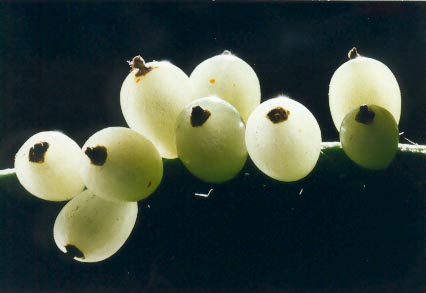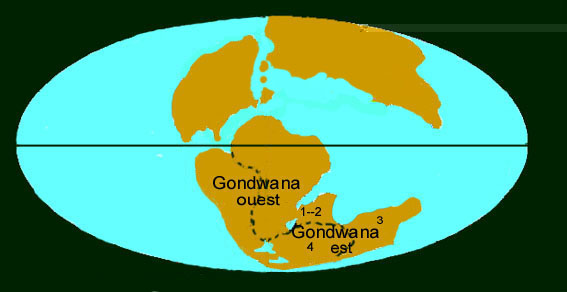**** DEBATED HISTORY OF RHIPSALIS ****

fruits of Rhipsalis baccifera
Rhipsalis is the only cacti genus present in the Old World.
I don't include the cacti species which were disseminated by humans following the discovery of the New World by Christopher Columbus and other great European Navigators.
Among these recently disseminated species, I particularly think of Opuntia ficus-indica (the prickly pear tree, used as defensive hedges, to feed animals, and for its fruit). There is also Hylocereus undatus, grown for the production of its fruit (Dragon Fruit, or Pitahaya, or Pitaya).
It is told briefly in the French language books which I read : these books hint at the possible post-Colombian dissemination by European sailors who would have used Rhipsalis as a substitute of mistletoe used for New Year. We are also told without further arguments about the possible seeds' transfer of Rhipsalis from the America continental plate towards the Africa plate, in the excrements of migratory birds.
I shared these points of view (as nearly everybody else) until I read, on the English speaking reference website : "Rhipsalis.com" a fascinating article written by Doctor Phil Maxwell, an article originally published in the "New Zealand Cactus and Succulent Journal".
I wrote here a very short summary of this article, but I highly recommend you, by using the following link, to immerse in the original text of this article which suggests a new way.
"The Rhipsalis Riddle - or the day the cacti came down from the trees"
_______________________________________
Very brief summary of the article:
In this article, the author reports on the Rhipsalis exception, the only cacti genus widespread in the Old World as a wild plant.
He first evokes the scientific context of the era when the Rhipsalis case started to be discussed (20th century): Darwin's theory of the Species Evolution, theories of Continental Drift and then of tectonic plates, which raised doubts about the stabilist geology.
He evokes and discusses then the various assumptions which were brought forward to explain the Rhipsalis exception :
1- Post-Colombian dispersion by humans.
2- Dispersal by Birds or by Rafting.
3- Vicariance.
The author tends to favour the last option : Rhipsalis would be a genus much older than thought, which appeared approximately 150 Ma (million years ago), at the beginning of the angiosperm appearance, in the western part of Gondwana, formed by the juxtaposition of South America and Africa, not really separate yet.Then Rhipsalis would have spread across all Western Gondwana, until reaching Madagascar and India (still attached to Gondwana), approximately 130 million years ago, whereas East Gondwana (Australia, New Zealand and the Antarctic) had already moved away from West Gondwana. This explains the current Rhipsalis locations.
Lastly, the author considers the consequences of this option on the cacti evolution.
_______________________________________
Personal note:

Distribution of the continents, approximately 150 Ma (million years ago).
( 1-Madagascar + 2-India + 3-Australia + 4-The Antarctic) : East Gondwana
_______________________________________________
ENTER THE GALLERY OF ALL MY RHIPSALIS PHOTOS FROM 2002 TO 2012
______________________________________________________